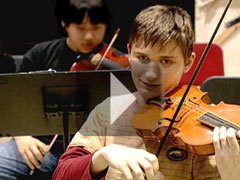Berberi’s Tools: Technology Can Level the Learning Field
New devices are giving special-needs students opportunities they’ve never had before.
Your content has been saved!
Go to My Saved Content.All students can benefit from using technology to develop 21st-century skills and to prepare for the jobs of the future. But technology also serves another important function for the more than 6 percent of the student population, or more than 2 million children, who have physical or learning disabilities: Technology can help democratize learning for many of these students and level the learning field by enabling them to participate in the same learning and social experiences as their peers.

Research on visually impaired students indicates that only 40 percent of such students are using the kind of technology that Albano Berberi -- a blind Advanced Placement computer science student, devoted gamer, and violin prodigy -- employs every day. Many teachers are not aware of how useful these technologies are. Others are simply not comfortable with incorporating the devices into their instruction.
The situation is the same for students with other disabilities. National surveys have found that no more than 35 percent of students with diagnosed disabilities are receiving assistive technology as part of their federally mandated individualized education plan (IEP).
Transformative Technology
Technology can transform the classroom for these students in many ways: Those too ill to attend school can use webcams to be virtually present in class. Students who lack the motor control to grip a pencil can use a variety of tools, such as portable note takers, laptop computers, or digital recorders to record lecture notes and classroom assignments and otherwise participate in learning. Students with writing difficulties can use word-prediction software to assist them in writing.
Technology has provided students with disabilities the opportunity to express themselves in new ways. One young autistic woman posts videos on YouTube about living with her condition. Using a communication device to speak, she shares with viewers the challenges in completing simple tasks -- such as boiling a pot of water -- and explains the thoughts and feelings behind her movements and gestures. In previous years, visually impaired students would not have had access to Braille versions of every textbook. Now, with a scanner and a computer, these students can access any book.
In the video that accompanies this article, viewers can see how Albano Berberi uses a variety of technology tools to support taking notes in class, writing lines of code on a computer, and chatting online with friends. Here are some of the tools he uses throughout his day:
- Refreshable Braille Displays. Berberi uses a refreshable Braille display to use his Braille note taker in music class. Such displays raise or lower combinations of pins to reproduce, in Braille, the information on the computer screen. Users run their fingers over the display in order to read the text, and the display refreshes as the user moves around the screen.
- Braille Note Takers. Electronic Braille note takers are portable devices designed for individuals who are blind or are vision impaired. Users can input information using a Braille keyboard, and the device outputs information using a speech synthesizer and a refreshable Braille display. Many note takers can be used for email, word processing, and taking notes in class. Users can transfer documents from the notetaker to a personal computer, which allows students to easily access and share their work.
- Screen Readers. Students who are blind or are vision impaired can use screen-reader software to identify and interpret what is displayed on a computer screen, providing them with access to programs not specifically designed for those with vision impairments. Berberi, for example, uses a screen reader called JAWS (Job Access With Speech) to work on his computer programming. Such devices use either a synthesized speech program or a Braille refreshable display to present to the user everything that appears on screen, including tool bars, commands, buttons, and text. When it comes to computer programming, this tool gives Berberi an edge over his peers because the speech output forces him to check lines of code in an orderly fashion. His peers, on the other hand, are often not so systematic.
More and more of these types of technology are becoming standard features in computer operating systems. For example, recent versions of Microsoft Windows include Narrator, a basic screen reader, and Apple computers ship with a similar program, VoiceOver.
Though these programs are simple, and most vision-impaired users will still need to purchase more robust screen-reading software, they represent a major step forward. With built-in screen readers, individuals with visual impairments can now access the basic functions on any computer; they're no longer limited only to computers with installed adaptive software.
Screen readers are also invaluable to users with print disabilities. They can access a spoken version of the text as well as accompanying features, such as voice notes, highlighters, and linked dictionaries.
Voice-Output PDAs and Wireless Handheld Devices
With wireless handheld devices such as personal digital assistants (PDAs), BlackBerrys, and iPhones, users can access the Internet, check email, play music, store important information, and keep track of appointments and assignments. Many of the newer devices offer built-in wireless capabilities, options for storing and playing digital books, music, and podcasts, the ability to record voice notes, and a word processing feature.
These options allow users with visual impairments to employ the device as a PDA and a digital-book player or to pair it with a Braille keyboard for note taking and Internet access. When video viewers see Berberi at home, he is using such a device to communicate with others.
For more information on many of these tools, see TechMatrix, an online tool from the National Center for Technology Innovation. This free resource provides up-to-date information and related research on more than 215 tools and devices for individuals with special needs.